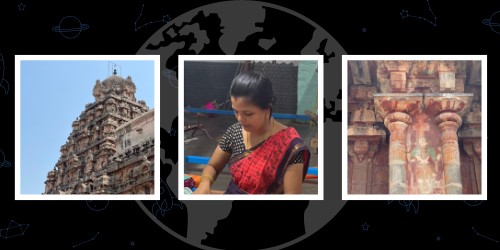這個月, 觀眾可以放映 Threads Of Tradition 在星球課堂網絡上. 該影片由 KIDS FIRST 為 Planet Classroom Network 策劃! 電影節.
Director Eshaan Mani presents 傳統的脈絡, delving into the lives and struggles of some of the last handloom weavers in India. The Arivu family resides in Darasuram village, South India, near the renowned Airavatesvara Temple. For generations, they’ve hand-woven traditional saris, but this 1000-year-old tradition is jeopardized by resource scarcity and the ascent of automated work.
全球搜索教育 welcomes Eshaan Mani.
Eshaan, where did you first learn about the people of Darasuram and their handweaving traditions? What motivated you to spotlight the Arivu Family’s story?
I’ve visited Darasuram’s massive Chola-era temple a few times during my summer trips to India. 然而, I hadn’t ventured into the town’s residential areas, mostly occupied by weavers. Their homes would have remained unknown to me if not for K Asokan, one of my film’s subjects. He approached my family at the temple and invited us to witness their age-old sari weaving tradition. Their warmth and willingness to showcase their work and share their stories motivated me to capture their narrative in a short documentary.
How did you capture the essence of their centuries-old tradition?
The heart and soul of my film lie in the interviews. If K Asokan and Tamizh Arivu hadn’t opened their hearts, this film wouldn’t exist. I loved hearing Tamizh’s childhood stories and Asokan’s pandemic survival account. The vibrant fabrics in their simple home, with dhotis and saris, each telling stories of their origins, added color. The b-roll footage, including their pedal-operated machine and Tamizh’s college graduation photo, helped capture the essence of these Saurashtrian Tamil weavers.
What were the significant challenges in filming this documentary? What memorable lessons did you learn?
謝天謝地, capturing this weaver family’s story posed little challenge. As my first non-English film, communicating the message effectively while considering language barriers was a challenge. Learning to add subtitles was a key takeaway. The conversations with K Asokan and his family were the most valuable part of the process.
Can you share insights on the cultural importance of preserving traditions?
Preserving traditions is crucial; losing them impoverishes us. It enriches cultural diversity, promotes respect among communities, and fosters peaceful coexistence. Many traditions, like crafts and music, hold economic significance, contributing to livelihoods and tourism, as seen in 傳統的脈絡.
謝謝, Eshaan!
C.M. Rubin with Eshaan Mani
不要錯過 傳統的脈絡, 現已在星球課堂網路上直播, 由 KIDS FIRST 策劃! 電影節.







最新評論